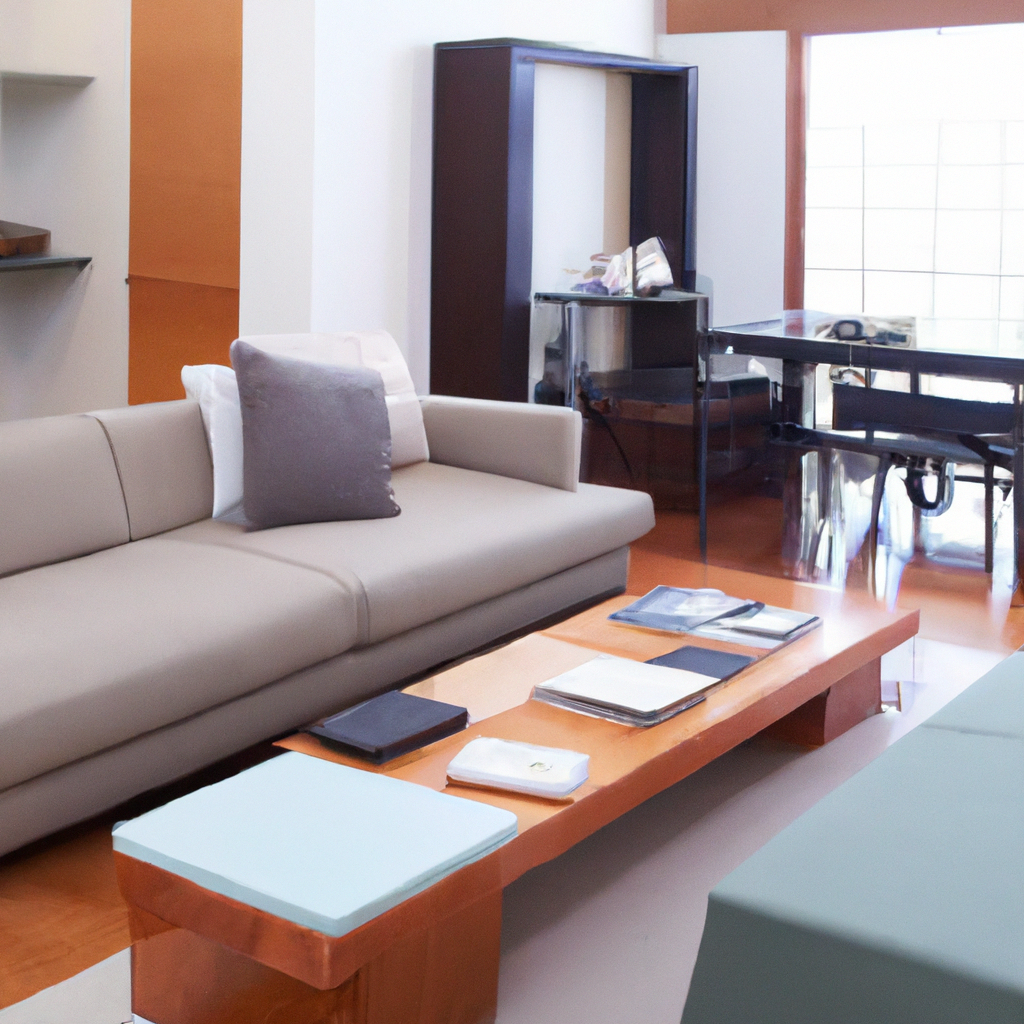Imagine transforming your living room into an eco-friendly oasis that not only enhances your comfort and convenience but also contributes to a sustainable future. In an era where technological advancements reign, it’s crucial to investigate whether there are any eco-friendly options available for creating a smart living room that aligns with your values. Discovering innovative solutions that blend cutting-edge technology with sustainable practices can pave the way for a greener and more conscious lifestyle. So, embrace the possibilities and embark on a journey towards a sustainable smart living room that harmonizes technology and environmental stewardship. Absolutely! When it comes to creating an eco-friendly and sustainable smart living room, there are plenty of options to choose from. Let’s explore some of the key areas where you can make environmentally conscious choices and integrate smart technology to reduce energy consumption and promote sustainable living.

Energy-efficient Lighting
LED Bulbs
LED bulbs have become a popular choice for energy-efficient lighting. These bulbs use significantly less energy compared to traditional incandescent bulbs, making them an eco-friendly option for your smart living room. LED bulbs also have a longer lifespan, reducing the frequency of replacements and minimizing waste. With an extensive range of options in terms of brightness and color temperature, you can easily find LED bulbs that suit your aesthetic preferences.
Smart Lighting
Taking energy efficiency to the next level, smart lighting systems provide an intelligent way to manage your lighting needs. These systems allow you to control the brightness, color, and timing of your lights, helping you customize the ambiance while minimizing energy waste. With features like motion sensors and smartphone integration, you can easily automate your lighting to ensure lights are only on when needed and adjust them even when you’re away from home.
Natural Light Optimization
Maximizing the use of natural light is another important aspect of an eco-friendly smart living room. Utilizing large windows, skylights, and light-colored walls can help bring in more natural light, reducing the need for artificial lighting during daytime. Additionally, installing smart window treatments such as automated blinds and shades can help regulate the amount of sunlight entering your room and maintain optimal lighting conditions while minimizing heat gain or loss.
Low-energy Consumption Electronics
Energy Star Certified Appliances
When choosing electronics for your smart living room, opting for Energy Star certified appliances is a great way to ensure they meet strict energy efficiency guidelines. These appliances are designed to consume less energy without compromising performance. From refrigerators and air conditioners to televisions and sound systems, Energy Star certified devices can significantly reduce your energy consumption and lower your environmental impact.
Smart TVs with Energy-saving Features
Smart televisions have become a centerpiece in many living rooms, and their energy consumption can add up over time. To address this, look for smart TVs that come with energy-saving features. These features automatically adjust the screen brightness, optimize power usage during standby mode, and incorporate energy-efficient components for reduced energy consumption. By choosing a smart TV with such features, you can enjoy your favorite shows and movies while minimizing energy waste.
Smart Plugs and Power Strips
Smart plugs and power strips offer an effortless way to control and monitor the energy consumption of your electronic devices. These devices can be connected to your home’s Wi-Fi network, allowing you to remotely control power to specific outlets or schedule automatic shutdowns when devices are not in use. By using smart plugs and power strips, you can prevent devices from drawing standby power and eliminate energy waste, ultimately saving both energy and money.

Sustainable Flooring
Bamboo Flooring
Bamboo flooring is a fantastic eco-friendly option for your smart living room. Bamboo is a fast-growing grass, making it a highly renewable resource compared to traditional hardwood flooring. Its durability and natural beauty make it an excellent choice for flooring, and with proper maintenance, it can last for years. Choosing bamboo flooring not only reduces deforestation but also adds a touch of natural elegance to your living space.
Cork Flooring
Another sustainable flooring option is cork. Cork is harvested from the bark of cork oak trees, which naturally regenerate after each harvest. This makes it an environmentally friendly choice, as the trees continue to thrive without being cut down. Cork flooring offers a unique texture and appearance, providing warmth and comfort to your smart living room. It also offers excellent insulation properties, helping to reduce energy consumption by retaining heat during colder months.
Recycled Carpet Tiles
For those who prefer carpeted floors, using recycled carpet tiles is a sustainable and versatile option. These tiles are made from recycled materials, such as plastic bottles and nylon fibers, reducing the demand for new resources. They are also designed to be easily replaceable, so you can simply replace individual tiles if they get damaged or worn out, rather than replacing the entire carpet. Recycled carpet tiles not only promote sustainability but also offer a wide range of colors and designs to suit your interior style.
Smart Thermostats and Energy Management Systems
Programmable Thermostats
Installing a programmable thermostat in your smart living room is a simple yet effective way to reduce energy consumption. Programmable thermostats allow you to set different temperature schedules based on your daily routines. This means you can automatically adjust the temperature to be lower when you’re away or asleep, and have it comfortable when you’re actively using the space. By optimizing your heating and cooling settings, you can conserve energy without sacrificing comfort.
Occupancy Sensors
Occupancy sensors are smart devices that can detect movement in a room and automatically adjust the temperature accordingly. By installing occupancy sensors in your living room, you can ensure that the heating or cooling system only operates when the room is occupied. This eliminates the need for manual adjustments and prevents unnecessary energy usage when no one is around. With occupancy sensors, you can effortlessly maintain a comfortable and energy-efficient smart living room.
Remote Control Temperature
Another convenient feature of smart thermostats is the ability to control the temperature remotely. With smartphone integration and Wi-Fi connectivity, you can easily adjust the temperature of your living room from anywhere, even when you’re not at home. This allows you to ensure energy-saving temperature settings are in place and can come in handy when unexpected changes in your schedule occur. By being able to remotely control your thermostat, you can maximize energy efficiency and reduce unnecessary heating or cooling.

Water-saving Fixtures and Appliances
Low-flow Showerheads
Conserving water is essential for a sustainable smart living room, and one way to achieve this is by installing low-flow showerheads. Low-flow showerheads limit the water flow rate while maintaining adequate water pressure, reducing water consumption during showers. These showerheads often incorporate aerators or innovative designs that mix air with water to create a satisfying and efficient shower experience, all while minimizing water waste.
Dual-flush Toilets
Toilets are one of the biggest water consumers in a household, but you can minimize their impact by using dual-flush toilets. Dual-flush toilets offer two flush options: a lower-volume flush for liquid waste and a higher-volume flush for solid waste. By providing different flushing options, these toilets allow you to use just the right amount of water for each flush, promoting water conservation without sacrificing functionality.
Smart Irrigation Systems
If you have houseplants or a small garden in your smart living room, utilizing smart irrigation systems can help you manage water usage efficiently. These systems use weather data, soil moisture sensors, and other factors to determine the optimal watering schedule for your plants. By accurately delivering water only when necessary, smart irrigation systems help conserve water and prevent overwatering, ensuring your plants thrive while minimizing waste.
Non-toxic Paint and Eco-friendly Wallpaper
Zero VOC Paints
Choosing paints with zero volatile organic compounds (VOCs) is a great way to create an eco-friendly smart living room. VOCs are chemicals that can be released into the air and contribute to indoor air pollution. By using zero VOC paints, you can reduce the emission of toxic substances, creating a healthier and more sustainable living environment. These paints are available in a wide range of colors and finishes, ensuring you don’t have to compromise on style.
Eco-friendly Wallpaper Materials
If you prefer wallpaper over paint, there are eco-friendly options available as well. Look for wallpapers made from sustainable materials such as recycled paper, bamboo, or natural fibers. These materials are renewable and biodegradable, minimizing the environmental impact. Additionally, some eco-friendly wallpapers use water-based or low VOC adhesives, further reducing chemical emissions and promoting a greener living space.
Natural Fiber Wallpaper
Natural fiber wallpapers, such as those made from grasscloth or jute, offer a unique and environmentally friendly alternative to traditional wallpapers. These wallpapers are crafted from natural plant fibers, providing a textured and organic look to your smart living room. By opting for natural fiber wallpaper, you can add a touch of natural elegance to your space while avoiding synthetic materials that may contain harmful chemicals.

Upcycled and Sustainable Furniture
Upcycled Wood Furniture
Choosing upcycled wood furniture is an excellent way to promote sustainability in your smart living room. Upcycled wood furniture is made from reclaimed or repurposed wood, giving a new life to materials that might otherwise go to waste. Whether it’s a coffee table, shelf, or entertainment center, upcycled wood furniture adds rustic charm and character while reducing deforestation and minimizing your ecological footprint.
Sustainably Sourced Materials
When selecting furniture for your smart living room, opt for pieces made from sustainably sourced materials. Look for furniture crafted from responsibly harvested wood or materials such as bamboo, rattan, or recycled plastics. By supporting furniture manufacturers that prioritize sustainability and ethical practices, you can contribute to the conservation of natural resources and encourage responsible production methods.
Environmentally Friendly Upholstery
Choosing upholstery made from environmentally friendly materials is essential for a sustainable smart living room. Look for furniture with upholstery made from organic cotton, hemp, or other natural fabrics. These materials are grown without the use of harmful pesticides and have a lower environmental impact compared to synthetic fabrics. Additionally, some manufacturers offer upholstery made from recycled materials, further reducing waste and promoting circular economy practices.
Smart Window Treatments
Automated Blinds and Shades
Smart window treatments, such as automated blinds and shades, offer both convenience and energy efficiency. These smart systems allow you to schedule the opening and closing of blinds or shades based on the time of day, reducing heat gain during hot periods and maximizing natural light during cooler times. With smartphone integration, you can easily control your window treatments from anywhere, ensuring optimal lighting conditions and enhancing energy savings.
Energy-saving Curtains
Energy-saving curtains are specifically designed to insulate your smart living room, helping to regulate temperature and reduce energy consumption. These curtains are typically made with thick thermal materials that provide excellent insulation properties. By blocking out drafts and reducing heat transfer, energy-saving curtains can minimize the need for excessive heating or cooling, resulting in significant energy savings.
Smart Glass and Window Films
For those looking to invest in smart window technology, smart glass and window films are worth considering. Smart glass technology allows you to switch between transparent and opaque states, providing privacy or controlling the amount of sunlight entering your living room. This feature can help reduce the need for artificial lighting without compromising privacy. Additionally, window films can be applied to existing windows to improve insulation, block UV rays, and reduce heat gain, creating a more energy-efficient and comfortable living space.
Smart Home Automation and Integration
Centralized Smart Home Hub
A centralized smart home hub is the backbone of a well-integrated smart living room. This hub acts as the command center, allowing you to control various smart devices and appliances from a single interface. By syncing your lighting, thermostat, entertainment systems, and other devices to a central hub, you can streamline operations, minimize energy waste, and create personalized smart routines that optimize comfort and efficiency.
Energy Monitoring Systems
Energy monitoring systems provide valuable insights into your smart living room’s energy consumption. These systems track the energy usage of individual appliances and provide real-time data that allows you to identify energy-saving opportunities. By identifying devices that consume excessive energy or identifying patterns of wasted energy, you can make informed decisions and adjust your habits to reduce energy consumption, lower utility bills, and promote sustainability.
Automated Energy-saving Routines
One of the benefits of a smart living room is the ability to automate energy-saving routines. For example, you can program your smart hub to turn off all non-essential devices when you leave the room or go to sleep. You can also set up schedules to adjust the lighting, temperature, and window treatments based on your daily routines. By automating energy-saving routines, you can optimize energy efficiency without the need for constant manual adjustments, making sustainable living effortless and convenient.
Indoor Air Quality Management
Air Purification Systems
Maintaining good indoor air quality is key to a healthy smart living room. Air purification systems help remove pollutants, allergens, and toxins from the air, ensuring a clean and breathable environment. Look for air purifiers with HEPA filters that capture microscopic particles effectively. Additionally, some smart air purifiers can be remotely controlled and provide real-time air quality data, allowing you to monitor and improve the air quality in your living room effortlessly.
Natural Ventilation Strategies
Promoting natural ventilation in your smart living room is an effective way to improve indoor air quality and reduce reliance on mechanical heating or cooling systems. By opening windows strategically, choosing window designs that facilitate airflow, and installing ceiling fans, you can enhance cross-ventilation and promote fresh air circulation. Natural ventilation not only lowers energy consumption but also helps remove indoor pollutants, creating a healthier and more comfortable living space.
Plant-based Air Filters
Incorporating plants into your smart living room not only adds a touch of natural beauty but also improves indoor air quality. Many plant species, such as spider plants, peace lilies, and snake plants, have air-filtering properties and can help remove common indoor pollutants. By strategically placing these plants throughout your living room, you can improve air quality naturally and enjoy the benefits of a healthier environment.
In conclusion, creating an eco-friendly and sustainable smart living room involves making conscious choices in various aspects of your room’s design and operation. From energy-efficient lighting and low-energy consumption electronics to sustainable flooring, water-saving fixtures, and non-toxic paint, there are numerous options available to promote sustainability. Introducing smart home automation and integration, along with managing indoor air quality, further enhances the efficiency and sustainability of your living space. By incorporating these eco-friendly options, you can create a smart living room that not only aligns with your technological needs but also minimizes your environmental impact and supports a greener future.
